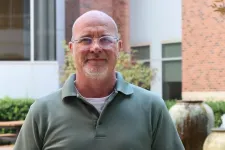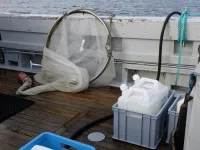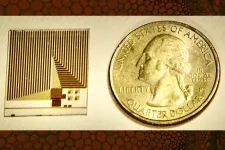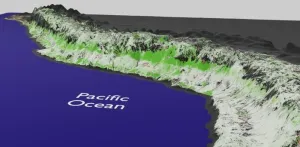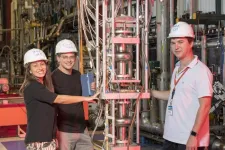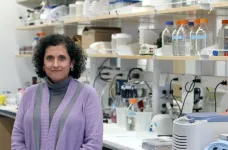(Press-News.org) Katy Börner’s team from the Luddy School of Informatics, Computing, and Engineering’s Cyberinfrastructure for Network Science Center has made significant contributions to constructing a Human Reference Atlas and has led or co-authored six research articles in a just-released HuBMAP package in Nature.
Börner, Victor H. Yngve distinguished professor of engineering and information science, and CNS director, leads one of the two mapping components within the NIH-funded Human BioMolecular Atlas Program. Her team includes experts from Indiana University, Stanford University, California Institute of Technology, Harvard Medical School, and the EMBL’s European Bioinformatics Institute in the UK.
The perspective, “Advances and Perspectives for the Human BioMolecular Atlas Program (HuBMAP),” provides an overview of recent accomplishments and detailed maps at single-cell resolution.
Ellen Quardokus, research scientist at IU, and Andrea Radtke, senior scientist at NIH, both members of the MC-IU team, lead the effort that resulted in “Organ Mapping Antibody Panels (OMAPs): A community resource for standardized multiplexed tissue imaging.”
“Organ Mapping Antibody Panels (OMAPs) and accompanying Antibody Validation Reports (AVRs) reflect the hard work and dedication of a team of domain experts in academia, industry, and government,” Radtke said. “Together, we have worked to overcome the cost, time, and expertise required to map human tissues using multiplexed antibody-based imaging. In addition to providing data on hundreds of community-validated antibodies for diverse imaging methods such as CODEX, IBEX, and Cell DIVE, OMAPs are aligned to data in the Human Reference Atlas, providing evidence for cell types in specific anatomical structures. We are excited to share these resources with the growing spatial biology community and look forward to accelerating discovery together.”
Yingnan Ju, Luddy School PhD candidate, and Börner collaborated with the GE research team on “3D reconstruction of skin and spatial mapping of immune cell density, vascular distance and effects of sun exposure and aging”.
“This paper seamlessly bridges the gap between practical industrial applications and my academic pursuits” Ju said. “We successfully integrated data visualization and machine learning, synthesizing the invaluable insights from my GE internship with my research at Indiana University. This collaboration has not only laid a solid foundation for future exploration but also added substantial value to my Ph.D. experience. I am excited and look forward to further collaboration."
CNS Research Scientist Andreas Bueckle was a contact author for “Tissue Registration and Exploration User Interfaces in support of a Human Reference Atlas.” The paper details the registration and exploration user interfaces that empower users to spatially register their data to one of the 66 3D reference organs and semantically and spatially explore the thousands of tissue blocks now mapped to the HRA. Users can do that in a 3D environment, deployed to a web browser and reachable by anyone with an internet connection and with hooks into the HuBMAP Data Portal.
“Building a Human Reference Atlas is a gigantic endeavor that requires skills and abilities from a diverse set of experts,” Bueckle said. “This necessitates tools with state-of-the-art user interfaces.”
Yashvardhan Jain, CNS Research Software Engineer is the lead author of “Robust and generalizable segmentation of human functional tissue units.”
“Construction of the Human Reference Atlas (HRA) requires a combination of human intelligence and machine intelligence,” Jain said. “Detecting and segmenting structures such as functional tissue units in human tissue images is an important step and needs efficient machine learning algorithms that can automate such tasks, enabling processing and analysis of datasets at scale.”
Jain said global data science competition platforms such as Kaggle can be leveraged to engage data scientists, machine learning engineers and researchers across the globe to accelerate the development of efficient, generalizable and scalable algorithms that can aid the development of such automated tools.
Griffin Weber, Harvard Medical School lead the team that published “Anatomical structures, cell types, and biomarkers of the healthy human blood vasculature”.
“The Human Reference Atlas-Vasculature Common Coordinate Framework (HRA-VCCF) dataset is the first open, computer-readable, and comprehensive database of the adult human blood vasculature,” he said. “It contains a list of blood vessels and their branching relationships, as well as associated cell types and biomarkers, the vessel type, anastomoses, portal systems, microvasculature, functional tissue units, links to 3D reference objects, vessel geometries (length, diameter), and mappings to anatomical structures the vessels supply or drain. Because the vasculature extends to all parts of the body, this database forms a core part of the Human Reference Atlas (HRA), linking together organ-specific datasets.”
You can explore a video of the envisioned VCCF.
The MC-IU team authored, “Specimen, Biological Structure, and Spatial Ontologies in Support of a Human Reference Atlas.”
The Human Reference Atlas is a multiscale, pan-tissue, three-dimensional digital atlas of the healthy human body. It provides standard terminologies and data structures for describing specimens, biological structures, and spatial positions linked to existing ontologies. As of July 2023, the atlas comprises 30 organs with 4,340 named anatomical structures, 1,474 cell types, and 3,842 characteristic biomarkers plus more than 1,200 anatomically correct reference objects. All data is available for free at the HRA Portal.
“We are excited to see the atlas grow in coverage and quality during the HuBMAP Production phase,” Börner said.
Their work was among a set of nine scientific papers released in the Nature family of journals describing breakthroughs in high resolution, multiscale and multimodal mapping of the human body in two and three dimensions.
HuBMAP researchers have published more than 270 scientific papers, presenting advances in software and experimental technologies, creating maps of healthy human tissues at the cellular level.
END
IU team contributes six research papers to Human BioMolecular Atlas Program collection in Nature
2023-07-21
ELSE PRESS RELEASES FROM THIS DATE:
Research supporting increased crop growth published in Proceedings of the National Academy of Sciences
2023-07-21
NORMAN, OKLA. – An article describing research conducted by John Peters, Ph.D., chair of the Department of Chemistry and Biochemistry, Dodge Family College of Arts and Sciences at the University of Oklahoma, and fellow researchers, has been published in the journal Proceedings of the National Academy of Sciences.
The article “Structural insights into redox signal transduction mechanisms in the control of nitrogen fixation by the NifLA system” explores the way bacteria regulate the expression of genes related to nitrogen fixation – the conversion of nitrogen in the air into ammonia that can help plants grow.
“Using small angle X-ray scattering ...
Fiber optic sensing tracks seismicity from injected carbon dioxide at Australian site
2023-07-21
Researchers at a field site in Victoria, Australia are among the first to use fiber optic distributed acoustic sensing (DAS) for high-precision tracking of induced seismicity from a small carbon dioxide (CO2) injection, according to a new study published in Seismological Research Letters.
The CO2CRC Otway Project in Victoria is a research test site for the subsurface storage of carbon dioxide, as one possible way to reduce the impacts of climate-warming carbon emissions. However, there is a risk of induced earthquakes after gigatons of carbon dioxide will be injected within the same geologic ...
Biosurfactants might offer an environmentally friendly solution for tackling oil spills
2023-07-21
Can biosurfactants increase microbiological oil degradation in North Sea seawater? An international research team from the universities of Stuttgart und Tübingen, together with the China West Normal University and the University of Georgia, have been exploring this question and the results have revealed the potential for a more effective and environmentally friendly oil spill response.
Oil leaks into the oceans are estimated at approximately 1500 million liters annually worldwide. This leads to globally significant environmental pollution, as oil contains hazardous compounds ...
Revealing HIV drug-resistance mechanisms through protein structures
2023-07-21
LA JOLLA (July 21, 2023)—Salk Institute researchers, in collaboration with the National Institutes of Health, have discovered the molecular mechanisms by which the human immunodeficiency virus (HIV) becomes resistant to Dolutegravir, one of the most effective, clinically used antiviral drugs for treating HIV.
The new study, published July 21, 2023 in Science Advances, reveals how changes to the 3D structures of integrase, an HIV protein, can lead to Dolutegravir resistance and how other compounds may be able to overcome this resistance.
“With HIV, one must think two steps ahead of the virus,” says ...
New sensor mimics cell membrane functions
2023-07-21
CAMBRIDGE, MA -- Drawing inspiration from natural sensory systems, an MIT-led team has designed a novel sensor that could detect the same molecules that naturally occurring cell receptors can identify.
In work that combines several new technologies, the researchers created a prototype sensor that can detect an immune molecule called CXCL12, down to tens or hundreds of parts per billion. This is an important first step to developing a system that could be used to perform routine screens for hard-to-diagnose cancers or metastatic tumors, or as a highly biomimetic electronic “nose,” ...
The Pacific slope of Peru is greening, and this is not good news
2023-07-21
Analysing satellite data spanning the past 20 years, the research team based at the Cavendish Laboratory in Cambridge examined how vegetation has been changing along the Pacific coast of Peru and northern Chile. This area is known for its unique and delicate arid and semi-arid environments.
The analysis revealed that certain areas experienced positive vegetation growth, known as greening, while others displayed negative trends, referred to as browning. Unsurprisingly, the changes in vegetation are influenced by things like farming and urban development or change in ...
Dark SRF experiment at Fermilab demonstrates ultra-sensitivity for dark photon searches
2023-07-21
Scientists working on the Dark SRF experiment at the U.S. Department of Energy’s Fermi National Accelerator Laboratory have demonstrated unprecedented sensitivity in an experimental setup used to search for theorized particles called dark photons.
Researchers trapped ordinary, massless photons in devices called superconducting radio frequency cavities to look for the transition of those photons into their hypothesized dark sector counterparts. The experiment has put the world’s best constraint on the dark photon existence in a specific mass range, as ...
Extracellular vesicles could aid spread of scleroderma-caused fibrosis throughout body
2023-07-21
Extracellular vesicles, responsible for cell-to-cell communication, might be a driver of fibrosis in systemic sclerosis, according to a recent paper in Arthritis and Rheumatology.
Characterized by stiff and hardening tissue known as fibrosis, systemic sclerosis – also known as scleroderma – can affect the skin as well as other organs. Most research has focused on the pathology and starting point of fibrosis, but researchers at the Medical University of South Carolina are focusing ...
Ricardo Valerdi named Head of Systems and Industrial Engineering at the University of Arizona
2023-07-21
Ricardo Valerdi was selected as head of the Department of Systems and Industrial Engineering after a national search that yielded a highly competitive pool of candidates after serving as interim head for the 2022-2023 academic year.
“When I joined SIE 12 years ago, it looked very different,” said Valerdi. “Today we have a new generation of talented and ambitious faculty who are impacting our society’s Grand Challenges in manufacturing, transportation, aerospace ...
BioIVT to discuss its pivotal role in liquid biopsy research at the AACC Annual Scientific Meeting and Clinical Lab Expo
2023-07-21
BioIVT, a global research partner and biospecimen solutions provider for drug and diagnostic development, today announced that it will highlight the integral role it is playing in liquid biopsy research at the American Association for Clinical Chemistry (AACC) Annual Scientific Meeting and Clinical Lab Expo. This conference will be held from July 23-27 at the Anaheim Convention Center in Anaheim, CA.
“Liquid biopsy research can revolutionize the way we detect, diagnose, and treat diseases. However, several issues need to be resolved before it can reach its full potential. They include adopting ...
